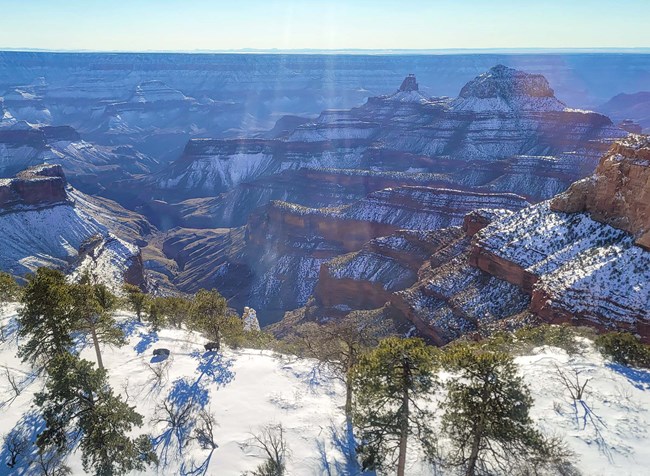Last updated: March 8, 2023
Article
Bison Bellows: Grand Canyon National Park

NPS Photo/J. H. Thompson
Classified as one of the Seven Natural Wonders of the World, it is hard not to image the mile-deep canyons, the winding Colorado River, and the archeological spectacles when thinking about the Grand Canyon. Grand Canyon National Park is a traveler's paradise, with 277 miles of river, 4,300 archeological resources, and the famous 21-mile "Rim to Rim" trail. But what most people don't imagine is the herd of roughly 500 free-ranging wild bison that call the Kaibab Plateau, inlcuding North Rim of the park and adjacent lands, home.
The Kaibab Plateau bison herd living in Grand Canyon National Park today are descendants of 86 bison brought to Arizona by Charles "Buffalo" Jones in 1906 from Kansas, some that were captured from the wild in Texas. Jones was well known for his efforts to save bison from extinction, and like other ranchers who took the lead for bison conservation, he tried to crossbreed bison with cattle.
With limited knowledge about genetics, his attempts largely failed as a cross between a bison bull and a domestic cow results in a viable female offspring and no viable male offspring. Therefore, if one sex is absent or sterile, there is evolutionary incompatibility between the two species, indicating that a true hybrid is not possible. Buffalo Jones recognized this after a few years of experimenting and sold off some animals, while the remaining 15-20 animals were largely abandoned until sold to Arizona in 1928.
Today, studies show that a majority of the bison living in Grand Canyon National Park do possess some evidence of cattle mitochondrial DNA---the DNA individuals inherit from their mothers---although no one has intentionally crossbred the Grand Canyon bison herd with cattle for over 100 years. While mitochondrial DNA can potentially influence the cellular physiology of bison, a large majority of heritable traits seen are coded by chromosomal DNA---the structure containing most of the DNA in an organism. The presence of both mitochondrial DNA and minimal levels of chromosomal DNA may have insignificant influence on the reproductive processes and phenotypic expression of the bison herd today. In other words, the Kaibab Plateau bison herd are indeed mostly bison, for they look and behave like other wild bison conserved across North America.
Early 20th century bison-cattle hybridization experiments failed and have not been repeated since, but they continue to confuse public perceptions about "pure" bison. Scientific studies show that only a few bison conservation herds today do not possess some lingering evidence of small amounts of cattle genes. Many of these herds are considered valuable for the conservation of the species. The bottom line, for such a deep park, is that the genetics of the Kaibab Plateau bison herd can be improved, but do not invalidate them as an ecologically relevant wild bison herd contributing to the large-scale conservation efforts. Instead of focusing on the failed crossbreeding experiments with cattle a century ago, managers today are working together to ensure the long-term viability of the species.
Update: March 2023
The National Park Service will reduce the size of the Kaibab Plateau Bison Herd by 2025 through capture and relocation, and lethal culling. The Environmental Assessment, Finding of No Significant Impact and other documents can be found on the NPS Planning Environment and Public Comment (PEPC) website.
Operational details of herd reduction are ongoing and more information, including volunteer opportunities, will be announced through a news releases. This website www.nps.gov/grca is the best source of up-to-date information. If, after browsing the information below, you are unable to find the answers to your questions email them to us at: e-mail us.
